
The Episcopal Diocese of Washington is a diocese of the Episcopal Church covering Washington, D.C., and nearby counties of Maryland in the United States. With a membership of over 38,000, the diocese is led by the Bishop of Washington, Mariann Budde. It is home to Washington National Cathedral, which is the seat of both the diocesan bishop and the Presiding Bishop of the Episcopal Church.

The Archdiocese of Indianapolis is a Latin Church diocese of the Catholic Church in Indiana in the United States.

The Episcopal Diocese of Tennessee is the diocese of the Episcopal Church in the United States of America that covers roughly Middle Tennessee. A single diocese spanned the entire state until 1982, when the Episcopal Diocese of West Tennessee was created; the Diocese of Tennessee was again split in 1985 when the Episcopal Diocese of East Tennessee was formed. It is headquartered in Nashville, Tennessee.

The Episcopal Diocese of Georgia, USA is one of 20 dioceses that comprise Province IV of the US Episcopal Church, and is a diocese within the worldwide Anglican Communion. The current bishop is Frank S. Logue, who succeeded Scott Anson Benhase on May 30, 2020, when he was consecrated 11th bishop of Georgia at a service held in Christ Church in Savannah, Georgia.

The Episcopal Diocese of Connecticut is a diocese of the Episcopal Church in the United States of America, encompassing the entire state of Connecticut. It is one of the nine original dioceses of the Episcopal Church and one of seven New England dioceses that make up Province 1.

The Episcopal Diocese of Upper South Carolina (EDUSC) is a diocese in the Episcopal Church.
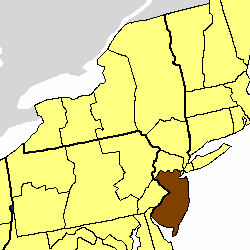
The Episcopal Diocese of New Jersey forms part of Province II of the Episcopal Church in the United States of America. It is made up of the southern and central New Jersey counties of Union, Middlesex, Somerset, Hunterdon, Mercer, Monmouth, Ocean, Burlington, Camden, Atlantic, Gloucester, Salem, Cumberland, and Cape May. It is the second oldest of the nine original Dioceses of the Episcopal Church. Services began in 1685 at St. Peter's, Perth Amboy, the oldest parish in the diocese. The diocese itself was founded in 1785.
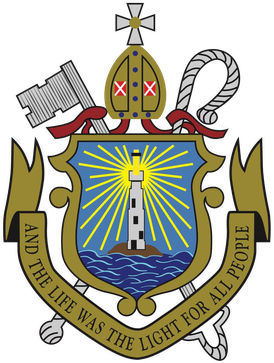
The Episcopal Diocese of Northern Indiana, originally called the Episcopal Diocese of Michigan City, is the diocese of the Episcopal Church in the United States of America with jurisdiction over the northern one-third of Indiana. It is in Province 5 and its cathedral, the Cathedral of St. James, is in South Bend, as are the diocesan offices.

The Episcopal Church in Wyoming is the diocese of the Episcopal Church in the United States of America with jurisdiction over the state of Wyoming, except for one congregation in western Wyoming which is included in the Episcopal Diocese of Idaho. It was established in 1887 and is in Province VI. Its cathedral, St Matthew's Episcopal Cathedral is in Laramie while the diocesan offices are in Casper.

Christ Church Cathedral is the cathedral for the Episcopal Diocese of Indianapolis. Christ Church parish was formally organized in 1837. The present-day church building was erected in 1857 on Monument Circle at the center of downtown Indianapolis to replace the parish's first church built on the same site. Designed by architect William Tinsley, the English Gothic Revival-style structure is the oldest church building in Indianapolis and Marion County, Indiana, that has remained in continuous use. It is also the oldest building on Monument Circle. Christ Church is known for its music, especially its pipe organs, one of which was donated by Ruth Lilly, and its professional Choir of Men and Boys and Girls' Choir. The parish is also known for its community service, including an annual strawberry festival fundraiser and other charitable work. Christ Church Cathedral was added to the National Register of Historic Places on July 10, 1973. It is located in the Washington Street-Monument Circle Historic District.

The Episcopal Diocese of Southern Ohio is the diocese of the Episcopal Church in the United States of America with jurisdiction over 40 counties in southern Ohio. It is one of 15 dioceses that make up the Province of the Midwest. The offices of the Bishop of Southern Ohio and the cathedral, Christ Church Cathedral, are both located in downtown Cincinnati.

St. Mary Catholic Church is a parish of the Roman Catholic Church in Indianapolis, Indiana, in the Archdiocese of Indianapolis.
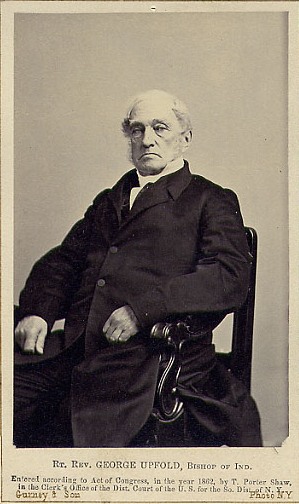
George Upfold was the first Episcopal Bishop of Indiana after the diocese's division from the Missionary Diocese of the Northwest. He is officially styled, though, as II bishop of Indiana since missionary bishop Jackson Kemper is styled I bishop of Indiana.
The Diocese of Vincennes was the first Latin Church diocese in Indiana. It was erected 6 May 1834 by Pope Gregory XVI. Its initial ecclesiastical jurisdiction encompassed Indiana as well as the eastern third of Illinois. In 1843 the Diocese of Chicago was erected from the Illinois portion of the diocese, and in 1857 Diocese of Fort Wayne was erected from the northern half of Indiana. The seat of the episcopal see was transferred from Vincennes, Indiana, to Indianapolis, and on 28 March 1898 it became the Diocese of Indianapolis. Pope Pius XII elevated the Indianapolis diocese to an archdiocese in 1944, and erected two new Indiana dioceses: the Diocese of Evansville and the Diocese of Lafayette. The Diocese of Gary, Indiana, was erected in 1956. The Evansville Diocese absorbed the city of Vincennes upon its creation.
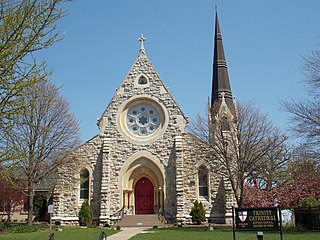
Trinity Episcopal Cathedral, formerly known as Grace Cathedral, is the historic cathedral in the Diocese of Iowa. The cathedral is located on the bluff overlooking Downtown Davenport, Iowa, United States. Completed in 1873, Trinity is one of the oldest cathedrals in the Episcopal Church in the United States. It was individually listed on the National Register of Historic Places in 1974. In 1983 the cathedral was included as a contributing property in the College Square Historic District, which is also listed on the National Register.

The Episcopal Church of All Saints serves the Old Northside Historic District near downtown Indianapolis. It is distinctive within the diocese for its Anglo-Catholic style of worship, and is historically significant as the first Episcopal Church in the United States to regularly ordain a woman as priest. The building also served as the cathedral of the Episcopal Diocese of Indianapolis from 1911 until 1954, when the bishop's seat was relocated to Christ Church Cathedral, Indianapolis.

Saints Peter and Paul Cathedral is a Roman Catholic cathedral located at Fourteenth and Meridian Streets in Indianapolis, Indiana, United States. It is the seat of the Archdiocese of Indianapolis, and of the Archbishop of Indianapolis, most recently Archbishop Charles C. Thompson. Silas Chatard, the first Bishop of Indianapolis, established the cathedral parish in 1892, and named it after Saint Peter and Saint Paul, two apostles of Christ. The cathedral parish became known for its liturgical celebrations and sacred music performances.
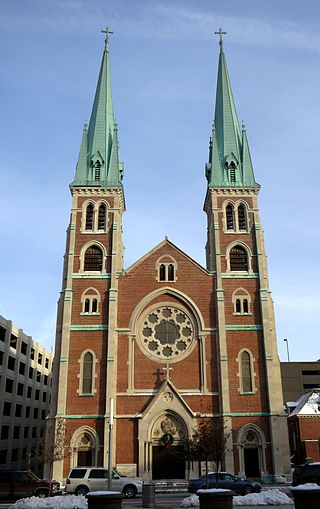
Saint John the Evangelist Catholic Church is a Roman Catholic parish of the Archdiocese of Indianapolis in Indianapolis, Indiana, United States. The parish's origins date to 1837, when it was first named Holy Cross parish. In 1850 it was renamed Saint John the Evangelist parish, and is the oldest Catholic parish in the city and in Marion County, Indiana. Considered the mother of the Catholic parishes in Indianapolis, it played an important role in development of the Catholic Church in the city. Saint John's Church served as the pro-cathedral of the diocese from 1878 until 1906; its rectory served as the bishop's residence and chancery from 1878 until 1892. In 1900 the church served as the site of first episcopal consecration held in Indianapolis.

Joseph Cruikshank Talbot was the missionary bishop of the Northwest and the third bishop of the Episcopal Diocese of Indiana.
Diedrich Augustus Bohlen a native of Cadenberge, Kingdom of Hanover, immigrated to the United States around 1851 and founded D. A. Bohlen, Architect, in 1853 at Indianapolis, Indiana. In 1971 it became Bohlen, Meyer, Gibson and Associates, and is among the oldest architectural firms in the United States still in operation. Bohlen is best known for introducing the German Neo-Gothic architecture style to Indiana. Bohlen and his firm specialized in institutional projects, especially civic, religious, and educational buildings. More than forty of the firm's projects are listed on the National Register of Historic Places, including several of D. A. Bohlen's designs: Morris-Butler House (1864); Saint John the Evangelist Catholic Church (1871), its rectory (1863), and bishop's residence (1878); Indianapolis's Roberts Park Methodist Church (1876) and Crown Hill Cemetery's Gothic Chapel (1877); and in collaboration with his son, Oscar D. Bohlen, the Indianapolis City Market (1886). The combined campus of Saint Mary-of-the-Woods College and the Sisters of Providence of Saint Mary-of-the-Woods make up the Saint Mary-of-the-Woods Historic District, the largest cohesive collection of Bohlen buildings. The District is of statewide significance on the National Register of Historic Places, for its contribution to architectural, educational and religious history.




















